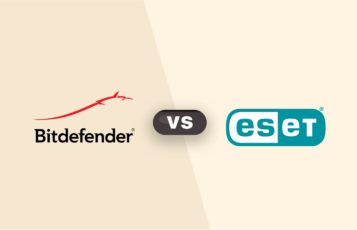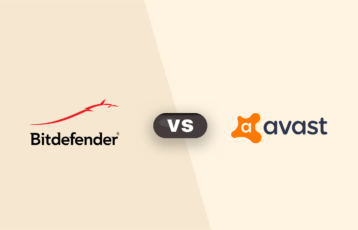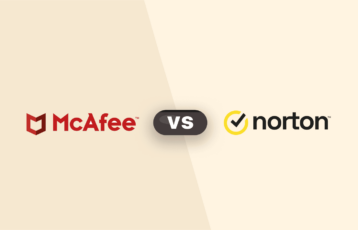If you use Windows as your regular operating system, you know that antivirus software is not optional. Seriously, unless you keep the device in question offline permanently (which is unthinkable), the lack of a good antivirus suite will take away your ownership over the system in a matter of hours or less. That brings us to the next problem, of course: what is the antivirus software that you should choose?
You can choose between free versions or paid ones. Microsoft provides Windows Defender pre-installed, as you probably know already. However, very few users consider that Windows Defender alone can keep their systems safe enough without the help of additional software.
Consequently, most users will search for options in the antivirus market. The market includes free versions as well as paid ones, and Avast is prominent among them. In this in-depth Windows Defender and Avast comparison, we help you decide which antivirus is better for you today.
Avast versus Windows Defender, head to head
Microsoft introduced Windows Defender as a comprehensive antivirus solution for Windows, starting with Windows 7. In the latest Windows versions, it’s an inbuilt feature. Obviously, Microsoft didn’t add this feature just because it had spare engineers to keep busy. Nevertheless, it forces a few questions to mind.
Is Windows Defender good enough to keep you safe from malware? Do I need antivirus software other than Windows Defender? Are there better options out there?
This guide will answer all those questions. Then, we will explore Windows Defender with some detail and write about Avast because many Windows users seem to like it very much. Last but not least, we will review Avast antivirus and Windows defender head to head. So let’s start at the beginning by having a look at Windows Defender’s primary features.
Windows Defender
Windows Defender provides real-time security against malware and virus. It’s an application running in the background that aims to provide Windows users with a basic degree of safety against harmful software.
Unfortunately, it comes by default with Windows, and you can’t get rid of it unless you install a different antivirus suite. It’s good that Microsoft saw at last how insecure Windows is and tried to provide something of a solution, jejune as it is. Let’s look at it, nevertheless.
Windows Defender’s strengths
- Resource efficiency. Most antivirus solutions are pretty resource-intensive. They suck up a lot of memory, space, and computing power. Windows Defender has an advantage over the competition in this regard: it’s developed in-house by Microsoft, so it’s inbuilt into Windows instead of being a separate solution. Thus, it’s more efficient than any antivirus suite. But is it better?
- Friendliness. Several reasons make Windows Defender a trendy choice among Windows users. You don’t need to move a finger to install it for a start. But also, it’s very simple. The setup process is straightforward. A minimal amount of intervention on the users’ part ensures smooth functioning. Windows Defender is ready to use out-of-the-box as soon as Windows is functional. Any other solution needs some initial setup.
- Find my device. Windows Defender enables you to build a connection with your device. This is a wonderful feature that allows you to locate your hardware if it’s lost. As a user, you will also lock the data you deem more sensitive or have it deleted if the computer is stolen.
- Parental control. Internet access for children is a nightmare for many parents globally, which is why this feature in Windows Defender is excellent. You can check any minor user’s screen time and closely follow the content they’re consuming. Additionally, there’s an automatic timer so you can limit the child’s screen time.
- File scrutiny. File analysis in Windows Defender is automatic, quick, and efficient, so it keeps the system very alert regarding malware attacks. It will let you know every time that a file is deleted because of its potential as a threat.
- Automated updates. A significant security weakness for Windows in the past was the update process. The data was always there, but very few users took the time to keep their computers current. Updates for Windows Defender are automatic, and they do not need a reboot to work correctly. Also, the new cloud-based malware database makes the institutional response to new threats much more agile than in the past.
- Firewall. Firewalls are the first level of protection against malware; they keep the attacks at bay. They check every connection to the exterior and restrict unapproved entries.
Those features are there, and we would very much like to say that they’re good enough to keep your computer safe. But, alas, we can’t. Unfortunately, not everything about Windows Defender is peachy, and we have to tell you about its limitations too.
Windows Defender weaknesses
- Malware detection scope. While there’s no doubt that the latest Windows Defender scope on malware and virus detection is the best that Microsoft has ever offered, the fact remains that it’s thoroughly inferior to other solutions. It can be good enough against malicious attacks, and it will keep your web browsing and email safe enough. But you will remain vulnerable to ever more frequent ransomware events and other attacks. Windows Defender is still not a comprehensive solution, and it remains to be seen if it will ever be. So, as long as it’s your only protection against digital wrongdoers, you are still easy prey to them.
- New definitions updates. Updating the latest virus definitions in Windows Defender remains a manual download. This is a huge problem. I’ve already mentioned how the lack of automated updates for Windows in the past played a significant role in the system’s security failures. Most third-party antivirus suites will automatically download and install new virus definitions in the background without you even noticing. But in Windows Defender, you have to do it yourself. And, if the past is any guide, most users won’t.
- Lack of unified alerts. Windows Defender does not provide you with any historical records, so the results or details of previous scans are never available for you to see.
- Oversimplification. Yes, I said that Defender’s simplicity was a good thing. Still, it can be so simple indeed that it limits your options for customization, thus preventing an effective all-around protection scheme from being deployed.
- Scanning speeds. File scanning in Windows Defender is the slowest of any antivirus suite in the market. While that could be one of the reasons it’s so efficient in terms of resources, speed is sometimes necessary.
So there, you have a panoramic view of Windows Defender as an antivirus solution. Let’s now turn our attention towards a different product that can give Windows Defender a run for its money. We refer, of course, to Avast antivirus protection.
Avast
Avast Software is the company behind the Avast antivirus suite, available in macOS, Android, and Windows versions.
The antivirus is free of charge for personal use. But, unfortunately, the prevalent idea is that free antivirus suites are little more than a digital band-aid that won’t provide you with the end-to-end security you can expect from paid products. That is a myth, and Avast is one of the suites that proves it wrong.
This free antivirus solution can compete with any paid big boys in the industry, offering a varied selection of features.
The Avast commercial offer is vast. First, of course, there is the free version, but several other options are loaded with exciting features that will keep you safe from malware. Let’s look at some of those options and their prices.
Read also: Bitdefender vs Avast.
Avast internet security
Price: 47.99 USD, yearly
Avast Internet Security provides total malware security. Additionally, it protects your system against every external threat; its email filter defends you from phishing attacks by examining incoming spam and junk mails from unknown senders.
Avast premier
Price: from 69.99 to 89.99 USD yearly, depending on the number of devices covered.
Avast Premier will give you every feature in Avast Internet Security plus an additional feature: the file shredder. This fantastic feature enables users to get rid of sensitive files that could be particularly risky for you if a hack happens.
Your webcam will be protected as the suite prevents its use as a spying tool.
Avast ultimate
Past: 99.99 USD yearly
This is Avast’s top-notch suite. The product is all-inclusive, offering several features along with the highest degree of security.
And there’s more. High-end features include a password manager, a VPN utility that will let you unlock geo-restricted content (making it one of the best antiviruses with VPN included). It also has a cleanup feature that gets rid of junk and spam files to keep your system lean and responsive.
Avast antivirus pros and cons
Let’s start by reviewing the best Avast has to offer:
Pros:
- Price. Avast has a deal for every budget. From the free option to the Ultimate bundle, money will never be a reason for somebody choosing Avast instead of Windows Defender. But, of course, the more you spend, the more you get.
- Scanning levels. Avast scans files and systems on several levels. In fact, it’s popular because of that very feature.
- Friendly. It’s easy to use without sacrificing customization or functionality.
- Multifunctions. There are several types of digital security threats out there, and Windows Defender doesn’t cover all of them. However, Avast does, and it detects some of them before they gain entry into your device.
- Efficiency. Avast promises to keep your device’s resource consumption low.
Avast’s advantages are evident, but nothing is perfect, especially in the digital security industry, in which 100% guarantees can’t exist. As a result, Avast has some limitations as well; here they are.
Cons:
- Low detection rate. This is probably Avast’s primary disadvantage. Even at its best, Avast is only effective at a rate of 60%. That leaves you at the mercy of the remaining 40% of threats. The most notorious items in that remaining category are rootkits and zero-day-exploits, which are detected very low in Avast or too late to make a difference.
- Upgrade popups. You’ll find yourself nagged by repeated requests to upgrade your software. This is not a deal-breaker, but it’s annoying for sure. Worse than that is that Avast is a very slow scanner when compared with other solutions.
- Low-security level. Avast’s free version is not the most secure suite in the family. That, on top of the company’s low detection rate, makes Avast a limited antivirus.
Windows Defender vs. Avast – Spot on comparison
| Windows Defender | Avast | |
| Ease of use | 3.5/5 | 5/5 |
| Minimal pricing | $0 | $59.99 per year |
| Free trial | NA | Lifetime |
| Money-back guarantee | NA | Yes |
| Compatibility | ||
| Android | No | Yes |
| IOS | No | Yes |
| Mac | No | Yes |
| Windows | Yes | Yes |
| Protection | ||
| Adware protection | No | Yes |
| Phishing protection | Yes | Yes |
| Rootkit protection | Yes | Yes |
| Spam | No | Yes |
| Spyware | Yes | Yes |
| Anti-Trojan | Yes | Yes |
| Anti-Worm | Yes | Yes |
| Chat/IM protection | No | No |
| Email Protection | No | Yes |
| Security | ||
| Auto scanning | Yes | Yes |
| Firewall | No | Yes |
| Manual scanning | Yes | Yes |
| Real-time protection | Yes | Yes |
| Registry startup scan | Yes | Yes |
| Prescheduled events | Yes | Yes |
| USB scan | Yes | Yes |
| Support | ||
| No | Yes | |
| Live | No | No |
| Phone | No | Yes |
| Ticket | Yes | Yes |
| Additional features | ||
| Tune-up | No | No |
| No | Yes | |
| Parental control | Yes | No |
| Safe browser | No | Yes |
| Smartphone optimizer | No | Yes |
| VPN service | No | Yes |
So there you have it. Windows Defender and Avast are the most popular options in Windows security, and now you know their strengths and weaknesses. So are they really so different that choosing one over the other is an easy task for every user?
We’ll make it easier to choose by comparing every feature in each option head to head.
Price
Windows Defender is available as an element of the Windows Operating System without any extra charge. On the other hand, Avast offers several paid options, but you can use it for personal purposes free of charge.
Resource efficiency
Both solutions have relatively high efficiencies and low resource consumption compared with most other antivirus options in the market.
Features
Windows Defender is the most basic antivirus option out there. Avast is, in contrast, loaded with helpful features. In addition, if you choose to pay the license for the Premium or the Ultimate packages, you’ll get even more features.
System performance
With Avast, you’ll hardly notice that your system is running antivirus in terms of speed or performance, which is a rarity for this type of software. Ironically, Windows Defender’s impact on a system is even higher than most other antivirus solutions.
User interface
Avast’s interface is simple and easy to navigate. It will pose no mystery, even for newbies. Windows Defender’s interface, on the other hand, could use a little work. It needs to launch before you can access the Windows Defender Security Center.
Availability and compatibility
Since Windows Defender is part and parcel of the Windows operating system, it’s available in Windows only. Avast is available in Android, Windows, and macOS.
Malware detection score
AV-comparatives tested both options and scored Windows Defender with 6/6 points and Avast with 5.5/6. Surprisingly, Avast scored below Defender, but there you have it.
Ads
Avast will keep nagging you with popups to upgrade to the premium version. But Windows Defender is ad-free.
User suitability
So who should use each option? Naturally, Windows Defender will be best for non-intensive users. So if you don’t spend a lot of time online and don’t keep critical data on your computer, that’s the option for you.
Avast is best if you spend more time browsing websites online and if your computer holds data vital for you.
Support
There is no customer support for Windows Defender itself, but you’ll have the standard Microsoft customer support.
Avast has good customer support available for Premium (or better) users only.
WiFi Protection
Windows Defender has no WiFi protection. However, Avast will notify you immediately if you’re connected to an unsafe network.
Email protection
Windows Defender will only protect the email that goes through Microsoft products. Avast works with all browsers and email clients.
Password manager
This option is available with Avast but not with Windows Defender.
Installation
Windows Defender and ready to use as soon as Windows is up and running. Avast needs an installation.
Final thoughts
We have reviewed for you the two leading players in the antivirus universe: Avast and Windows Defender – one is popular because it’s free, the other one because it’s unavoidable. We’ve shown you in detail the best features in each, as well as their weakest points.
Then, we compared both options, feature by feature and head to head.
So which one is best for you? There’s no general answer. If you understand the requirements each solution needs, as well as the features it offers and how they match your habits as a user, then you’ll be able to pick the option that suits you best. Fortunately, since both solutions are free, they are equally available for every user.
Avast’s detection rate is higher; it has better features. But Windows defender gives you a free service for a lifetime (and it won’t keep reminding you to upgrade).
As stated earlier, the best option is the one that suits your digital lifestyle. But speaking generally, Avast is the better antivirus suite because it offers a slightly better level of protection and offers many additional features that Windows Defender does not. In addition, its compatibility with other operating systems will save you money if you want your license to cover devices other than your computer.
FAQs
The short answer is no. AV-comparatives rated Windows Defender at 99.5% for detection. Avast came out on top of that with 100%. However, Avast has many advanced features that Windows Defender won’t offer you besides the detection rates. So when you take everything into account, Avast is a better option than Windows Defender.
Yes, it will. Every antivirus will use some of your computer’s resources so that it will reduce your system’s performance.
Windows Defender is a popular option for a basic protection level against malware and viruses – let’s not forget that it comes preinstalled in Windows. However, Avast is the better option for a user who spends more time browsing the internet or keeps more critical data in the system, even if it needs an installation because it offers better protection and many other features.
Avast is widespread, and it’s available for several operating systems. But it’s a good antivirus solution, and it comes packed with advanced features, even in its free version.


